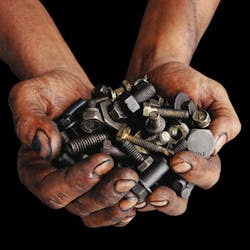But to withstand it, manufacturers will need to seek new ways of driving profitability. And one way to do so is to strategically price original equipment service parts. The pricing of spare parts used to service original equipment, such as home heating and cooling systems, and vehicles, has typically remained unchanged for lengthy periods of time. But customer sensitivity to spare parts prices is likely to increase, given the economy. Companies that can adjust their pricing strategies to capitalize on the changing market will have an alternative source to help sustain and enhance profitability during difficult times.First, companies must understand the market relative to where parts lie on the pricing spectrum. Some will belong to a captive market, where customers consider them a necessity, while others will be part of a competitive market and can easily be exchanged for similar, less expensive competing products. Companies that can distinguish between the two types of demand will be able to develop appropriate pricing strategies for profitability improvement.It also will be important to consider the impact of price on demand in a down economy. For example, pricing strategically to both win over a tentative customer and sow the seeds for a long-term relationship may be a key strategy in today’s environment.To determine whether pricing improvement opportunities exist, companies should look for three common indicators. A sales operation characterized by ad hoc discounting practices, significant giveaways in the form of rebates, terms or delivery, and deals that are often uniquely treated is typically the first indicator of a pricing improvement opportunity.Another sign is a weak infrastructure, which ineffectively communicates pricing and often includes pricing data maintained in different systems, or worse—no systems at all. The third indicator involves operating in a fast-paced, complex environment. Companies with fairly undifferentiated products that are challenged by low-cost competition create a scenario in which cost increases are difficult to pass on to customers. These conditions, combined with having a large product mix, high sales velocity or distributed sales channels, can create an environment of rapidly fluctuating prices that is ripe for strategic pricing improvements.Four stepsThe approach to establishing strategic parts pricing is generally a four-step process. The first step is to perform analysis that entails gathering intelligence on the industry, market conditions and the competition. This includes evaluating customers in terms of defining customer targets, the type of equipment they own, customer-perceived value of parts, and determining price elasticity. Profitability opportunities based on part categories, geographies and channels also are part of this step. Moreover, aligning this information with business objectives is key to developing an effective pricing strategy. The second step is to apply the results from the various analyses to define a parts pricing structure and pricing plans. Pricing structure and techniques should be tailored to meet the needs of a company’s specific business situation.Next, entertain “what if” scenarios before rolling out the new pricing structure. This should include assessing prices against the competition, determining expected sales volume and determining the bottom-line financial impact. This exercise will help ensure that proposed pricing changes are on target. The final step is to measure results with the understanding that it is not a one-time step. Companies should sustain a strategic pricing model that combines data, system tools, business acumen and training in analytics and technologies to effectively manage pricing.Adopting new approaches such as strategic parts pricing today will help manufacturers better manage the challenges of the downturn and position them to continue on the path to high performance as conditions improve.James Robbins, [email protected], is a senior executive for Accenture, a global management consulting, technology services and outsourcing company.
Subscribe to Automation World's RSS Feeds for Columns & Departments
About the Author
Sign up for our eNewsletters
Get the latest news and updates

Leaders relevant to this article:
